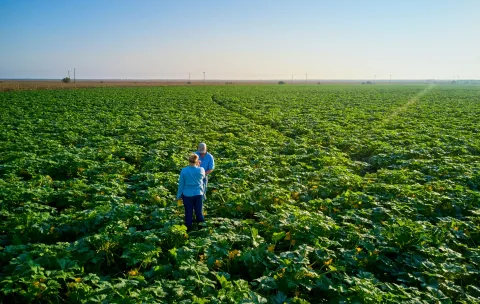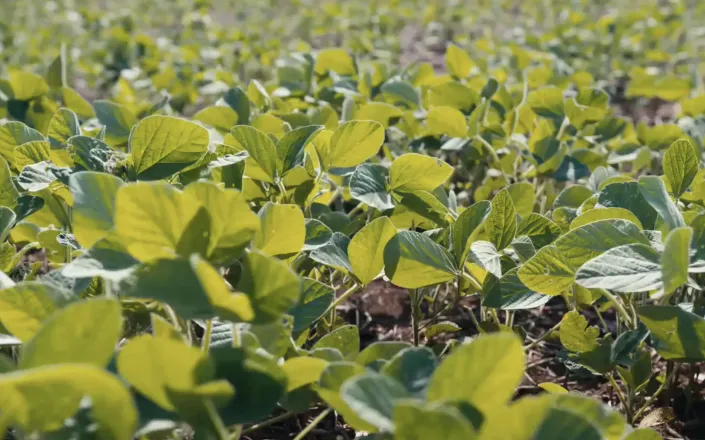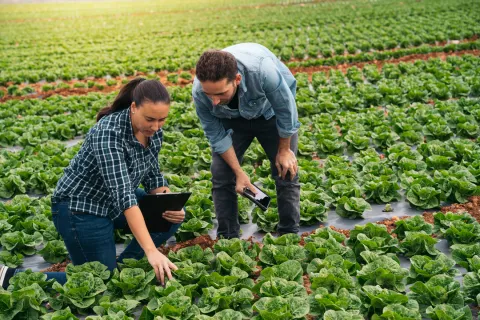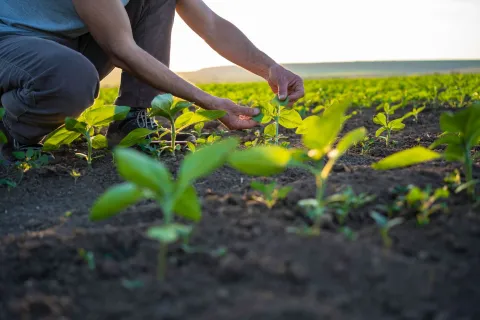
As an agri-tech leader, Syngenta is empowering farmers with the tools they need to produce more food to feed a rising population, while minimizing their impact on the environment. From our labs to the apps we design for farmers out in the field, we’re harnessing the power of artificial intelligence, or AI, to reimagine modern agriculture.
What is artificial intelligence?
Artificial intelligence, or AI, is a simple term for something that represents an enormous shift in how we live and work. It is the idea that intelligence – or our ability to learn, adapt, understand and put our knowledge into practice – can be simulated by machines and technology.
That means that technology can solve problems and learn, similar to humans. Fed enormous quantities of information, AI can also recognize patterns and generate new content. In practice, AI encompasses a range of technologies, including machine learning, deep learning, natural language processing, and robotics.
In daily life, AI can be used in simple day-to-day tasks, such as using a chatbot - like ChatGPT - to write emails, and in navigation, such as getting live traffic data on your commute home. And in agriculture, AI provides a wealth of opportunities to tackle a host of modern issues: from labor shortages to unpredictable weather patterns, to pest and disease pressures.
Agriculture is in the middle of a digital revolution – with Syngenta at the forefront.
How can AI be used in agriculture?

Predictive analytics and decision support
For farmers, AI can unlock an enormous amount of information that can help them to make smarter choices for their crops, and that protect the fields they grow on.
Despite the best intentions of growers, the whims of Mother Nature can make or break the health and quality of crop yields - and ultimately, farmers’ incomes.
So, arming growers with predictive tools that can forecast the weather conditions during specific times – such as during planting season – means they can plant their crops in the ideal conditions to thrive. These tools help farmers to manage risk, too. Being forewarned of a severe weather event opens a crucial window for growers to secure their crops and safeguard them as best they can. That can make the difference between a few rows of crops being damaged in a storm and the entire harvest’s worth of crops lost.
Such is the power of predictive performance analytics. It uses AI and machine learning to crunch through decades’ worth of historical data to predict outcomes and anticipate risks.
However, these analytical tools aren’t limited to weather forecasting. They can also be used to predict pest and disease threats, soil conditions, crop growth and yield potential.
It gives farmers real-time information on disease outbreaks and pest infestations, so they can apply treatments precisely when needed. That means growers can reduce their chemical use, minimize their environmental impact and be more sustainable on-farm.

Precision agriculture and crop monitoring
As the name suggests, precision agriculture is the method of monitoring and managing crops at a near-granular level. And that precision is achieved using technologies and AI-powered tools, including satellite imagery, computer vision, and machine learning algorithms.
The technology gives farmers a bird’s-eye view of their crops and soil, with a level of detail that humans couldn’t pick up – such as a plant’s nutrient deficiencies, or the earliest signs of disease and pest infestations.
Farmers can then use the precise amount of products that their crops need, when they need it – making it a more sustainable and cost-efficient practice.
Prescriptive agriculture
Just as a doctor would prescribe their patient a tailored plan with specific treatments, the power of AI means we can now take the same approach to growing our food. Because AI can give growers more data on their crops than ever before, they have more options to care for their crops in a tailored, precise way. That supports growers in achieving better outcomes, such as higher yields with less environmental damage.
Being able to observe, measure, and analyze the needs of crops and soil means growers can be more efficient in how they use resources to enhance their crop yield and quality.
Artificial intelligence plays a pivotal role here, by providing advanced data analytics and predictive insights, meaning farmers can make informed decisions tailored to their specific field conditions. Machine learning algorithms analyze vast amounts of data from sensors, drones, and satellite imagery to optimize planting schedules, monitor crop health, and predict pest outbreaks.

How can we responsibly use AI in agriculture?
At Syngenta, we see artificial intelligence as a tool to support our mission of providing farmers with the best technology and expertise to increase productivity and grow healthy, affordable and sustainable food.
And we’re committed to using AI responsibly – so much so, that we set down our intentions in our AI Manifesto. The manifesto’s 10 commitments guide our 60,000 global employees as they use AI in an ethical and responsible way. For example, this commitment includes ensuring human oversight in all stages of AI development and deployment.
AI systems at Syngenta are designed to support human decision-making rather than replace it, ensuring that critical decisions remain in the hands of experienced professionals. This approach helps maintain ethical standards and safeguards against unintended consequences. Transparency and accountability are also key principles in Syngenta’s AI strategy. We strive to provide clear and accessible information about how AI systems work, including their limitations and the data they use. By maintaining transparency, we ensure trust with farmers and other stakeholders, ensuring that AI technologies are used responsibly and effectively.
From AI inequity to opportunity:
Empowering the world’s farmers
Artificial intelligence is revolutionizing agriculture, but not all farmers are reaping the rewards.
Without a level playing field, this ‘AI divide’ risks widening the gap between smallholder farmers and large-scale operations.
But we can democratize the AI revolution. By ensuring that technology empowers all growers, no matter their farm’s size or location, we can stamp out AI inequity in agriculture.
Explore AI’s potential and the challenges of equitable access these two films, part of ‘The Human Component’ series, produced for Syngenta by BBC StoryWorks Commercial Productions.
From Syngenta CEO Jeff Rowe's high-tech farm in the USA to a smallholding in India, learn how our groundbreaking CROPWISETM offering is helping to democratize AI across different agricultural landscapes and about the critical role AI plays in sustainable agriculture.
Complementing these real-world examples, our groundbreaking study on ‘AI adoption across small vs. large farms’ will offer crucial insights on the AI divide and will chart a path forward on how to continue to close the gap.
We believe AI has the power to create a more sustainable food system. By developing an open, inclusive AI ecosystem, we're supporting farmers around the world with better access to technology, securing a better future for global food production.
Regenerative agriculture
Regenerative agriculture is a sustainable farming approach that focuses on restoring and enhancing ecosystem health by prioritizing soil health, biodiversity, and ecological balance.
Incorporating practices such as cover cropping, crop rotation, reduced tillage, and integrated livestock management, it can support farmers to improve their soil structure and sequester more carbon on-farm.
These practices aim to create a more resilient agricultural system that supports long-term productivity and environmental well-being. AI can play a key role in this, by optimizing resource use and improving crop management. Through advanced data analytics and machine learning, AI can analyze soil health, weather patterns, and crop performance to provide precise recommendations for planting, irrigation, and fertilization.
Discover our AI stories
You may also like








